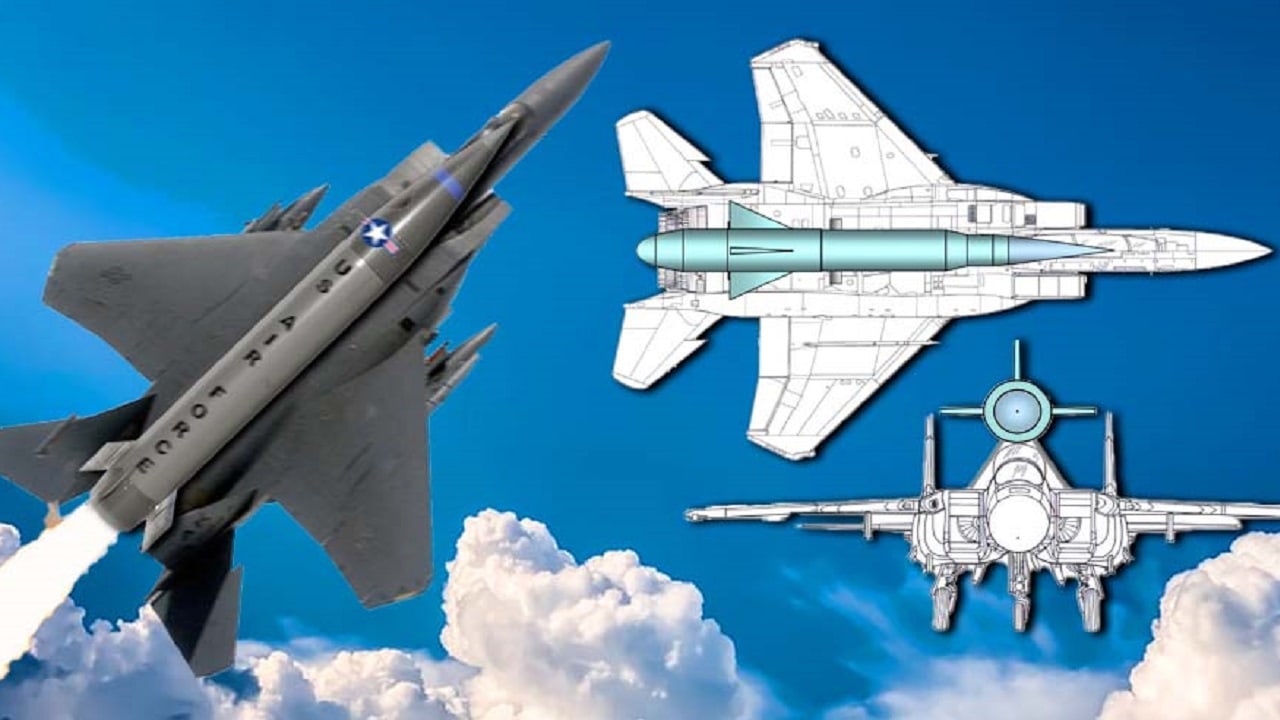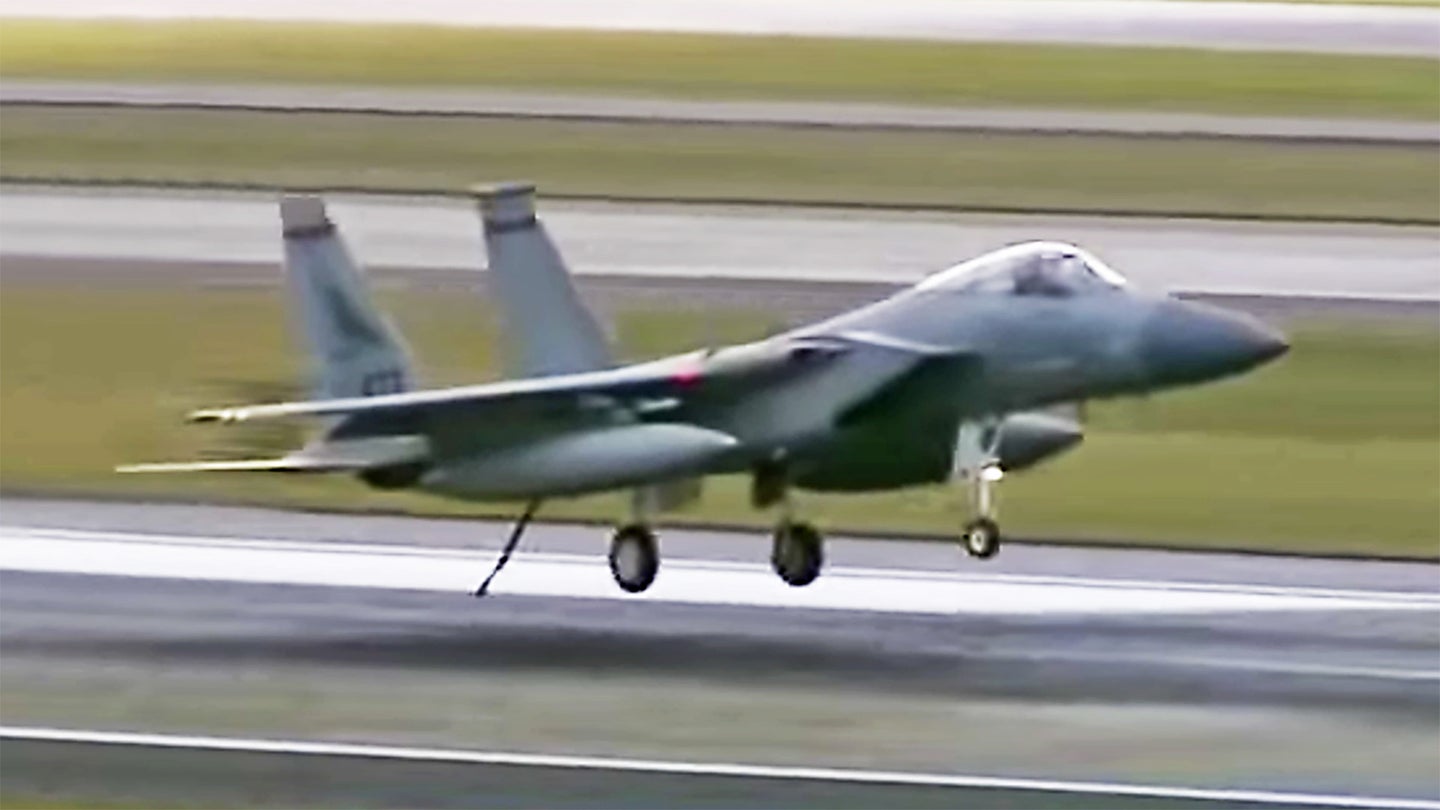F15 One Wing - 30°50′48″N 34°50′52″E / 30.8467°N 34.8478°E / 30.8467; 34.8478 Coordinates: 30°50′48″N 34°50′52″E / 30.8467°N 34.8478°E / 30.8467; 34.8478
In May 1983, two Israeli Air Force aircraft, an F-15 Eagle and an A-4 Skyhawk, collided mid-air during a training exercise over the Negev region of Israel. Remarkably, the F-15 (with a crew of two) managed to land safely at a nearby air base, despite its right wing being almost completely sheared off in the collision. The characteristics of the lifting body of the F-15, together with its abundance of thrust, allowed the pilot to realize this unique achievement.
F15 One Wing

On May 1, 1983, during an Israeli Air Force oddball combat training session over the Negev, an F-15D Eagle (or Baz) collided with an A-4 Skyhawk. The pilot of the Skyhawk automatically ejected and his plane disappeared. The right wing of the eagle was cut about 60 cm from the root. The crew of the two-seat trainer version of the F-15, pilot Zivi Nedivi and navigator Yehoar Gal, initially did not realize the extent of the damage, as fuel that leaked abundantly and evaporated near the wing mount view of the area covered where the wing used to be.
Us Confirms Fighter Jet Flew Close To Iranian Jetliner Above Syria, Leading To Passenger Injuries
The F-15 began to roll out of control after the collision, and the instructor ordered a jettison. Nedivi, who outmaneuvered the instructor, decided not to fire and tried to recover by measuring the afterburner and possibly gained control of the aircraft. He was able to maintain control through the lift from the large areas of the fuselage, the stabilators and the remaining wing. Redirects to Ramon Airbase,
The F-15 landed at twice the speed to maintain the necessary lift, and its tail hook was completely torn off on landing. Nedivi managed to bring his F-15 to a complete stop approx. 20 ft (6 m) from d of runway. He later told The History Channel, "it's very likely that if I had seen it clearly, I would have ejected because it was clear that you couldn't really fly a plane like that."
He added: "Only when [McDonnell Douglas] analyzed it later did they say, OK, the F-15 has a very wide [lifting] body; you fly fast and you're like a rocket. You don't need wings ."
The aircraft, 957 Markia Schakim of 106 Squadron (Hebrew: מרקיע שחקים, Sky Blazer), was transported by road to an IAF maintenance unit in Tel Nof, where it was repaired. Having already claimed four emy aircraft in the 1982 Lebanon War, the repaired aircraft would claim a joint kill on another Syrian MiG-23 on 19 November 1985. Two crossed lines forming an 'X'. It indicates a way to close an interaction or remove a notification.
Boeing To Build F 15 Fighter Planes
Home Chevron icon It indicates an expandable section or menu, or sometimes previous/next navigation options. Military and defense contributions
Twitter icon A stylized bird with open mouth tweeting. Twitter LinkedIn icon The word "in". LinkedIn Flipboard icon A stylized letter F. Flipboard Facebook icon The letter F. Facebook Email icon An envelope. It gives the possibility to send an email. Email Link icon An image of a chain link. It symobilizes a website link url. Copy link
The F-15 is a great aircraft designed to go head-to-head with the Soviets' MiG-25 and was the top dog for years, especially during Desert Storm when the US and Saudi Eagles took it to the Iraqis took in a big way.

The F-15 has endured because its design was years ahead of its time, and a good data point behind this fact is when Israeli pilot Zivi Nedivi landed his jet with only one wing.
Years Ago, This Pilot Flying A F 15 Fighter Jet Became 1st Person To Destroy A Satellite In Space
Nedivi had one of her wings sheared off in a mid-air collision with an A-4 Skyhawk during a training event.
Nedivi's Eagle went into a fast roll at the accident and he told his navigator to make the draft.
Nedivi ignited his afterburners in an attempt to stabilize the jet. The move worked. After his plane was stabilized, he decided to try to land at a base 10 kilometers away.
Due to the fuel from the damaged fuselage, neither he nor his wingman knew that the F-15 was missing a wing.
Sea Eagle: America's Plan To Put The F 15 On Aircraft Carriers
Read the original article on We Are The Mighty. Copyright 2016. Follow We Are The Mighty on Twitter Super sophisticated jets with state-of-the-art technology worth millions of dollars can sound like fragile things. The one small deformity will lead to a fatal crash. Although it may be in some cases, it is not always. An example of this is when an Israeli fighter pilot landed his F-15 Eagle - with a wing missing.
The accident occurred in 1983 during a training exercise in Israel with several A-4s and F-15s, when one of the F-15Ds, nicknamed Markia Shcakim, crashed right into one of the A-4s in mid-air flight (the pilot) of the A-4 ejects safely). The aircraft went into a tight spiral and there was a large fuel leak from the missing wing. You would think that the pilot would come out in such a situation, but that was not the case here. Instead, the pilot who was ordered to bail out (his name is Nedivi Zivi) regained control of the plane and intended to land at the nearest airport – 16 kilometers away. He might have reconsidered this if he knew the right wing was missing, but he didn't. He actually thought that the right wing had just sustained some damage in the collision with the Skyhawk, but because the wing is a bit difficult to see from the cockpit, he only found out how serious the damage to his plane was. it.
At one point I collided with one of the Skyhawks, at first I didn't realize it. I felt a big bump and I thought we were going through the jet stream of one of the other planes. Before I could react, I saw the huge fireball created by the explosion of the Skyhawk - Nedivi Zivi (F-15 Pilot)

In any case, his F-15 was running on steam as he approached the airport and he began to slow down. But again, when he missed one of the wings, the plane went into a new spin. Zivi thought he couldn't take it anymore and prepared to push out. But then he thought it was worth a try to light the afterburners, which can direct the plane out of the spin. It worked, and the Eagle was back on track.
Th Fighter Wing “heritage Jets”
He reached the base and touched down, with the tail hook lowered, at 300 kilometers per hour, which is about twice the speed recommended when performing a landing. Due to the high speed during the landing, the tail hook was torn away, but he was still able to bring the plane to rest - 10 meters before the arresting barrier.
When the plane was still and Zivi got out, he shook his instructor's hand and first noticed that the entire right wing of his fighter was missing. At the request of the Israeli Air Force, the manufacturer McDonnell Douglas (now Boeing) said that it was possible to fly the F-15 Eagle with one wing missing due to the lift of the fuselage and the power of the engine. But of course it is not an easy task and depends a lot on the skill of the pilot.
The F-15D Eagle received a new wing two months after the incident and was then back in the field. Although the McDonnell Douglas F-15 Eagle entered service nearly half a century ago, it remains one of the most powerful and capable air superiority fighters on the planet. The Eagle may not be as technologically advanced as its fifth-generation stablemates, the F-22 Raptor and the F-35 Joint Strike Fighter, but what it lacks in stealth, the F-15 makes up for in classic Cold War style: with incredible technique and good old fashioned brute strength. In fact, this aircraft is so capable - and powerful - that a pilot once flew an F-15 ten miles and then
Was definitely not considered a necessity for the Air Force, as it was the development of what would become America's Eagle in the 1960s.
File:f 22+f 117+f 4+f 15.jpg
Through much of the 1950s and the best part of the 1960s, it would not have been unfair to say that the Soviet Union won the Cold War. The space race up to that point had been largely one-sided, with the Soviets being the first to put a satellite, an animal and a person into orbit, as well as the first to reach the Moon, Venus and Mars with probes . In the skies above the ground, Soviet fighters were among the best in the world. The sweep-wing MiG-23 was widely considered superior to the American workhorse F-4 Phantom, but even more pressure was the Soviet MiG-25.
When the Pentagon first learned of the MiG-25 Foxbat in 1970, the plane's large wingspan, along with two powerful engines, suggested to intelligence analysts that it was a very capable fighter. These fears were reinforced in March 1971 when Israeli radar operators an unusual
One wing wool, f15 flies with one wing, israeli f15 one wing landing, f one wing foil, jordin sparks one wing, israeli f15 one wing, wing one thrower, wing one, f15 wing, f15 one wing landing, rogue one u wing, wing one clay thrower
0 Comments